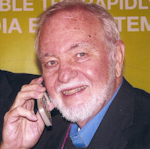Have you heard of this? It’s one more new wireless technology that may or may not be of value to you. In any case, iBeacon is Apple’s new Bluetooth-based wireless location service. It uses Bluetooth’s Low Energy (BLE), also called Bluetooth Smart, to implement beacons to send out a message that defines their location to nearby BLE smartphones. This new technology is bringing forth a whole new batch of uses.
The beacon is a BLE tag, sticker, or self-contained battery-powered gadget that is placed in a location that will allow it to reach nearby Bluetooth devices like iPhones or Android phones. The iBeacon tag has a range of around 40 to 50 feet in an indoor environment but could reach up to 100 feet or so in an outdoor setting with a clear line of sight path. The beacon pulses out a signal that is then received and acknowledged. The beacon then sends out a desired message to the phone.
Applications are just beginning to appear and offer a wide range of possibilities. The most mentioned application is push ads for retail stores and restaurants. In a mall of shopping area, you would automatically receive sales notices or menu selections once you are in range of the store and if you have the appropriate iBeacon app. Any geo-fencing application can be applied to iBeacon. Geo-fencing uses the BLE range to define a virtual boundary. Once you are within that “fence” you can take part in whatever applications are running.
Some possible uses are trail markers in parks and stops on a museum tour. Recently Major League Baseball installed iBeacon tags in ball parks to give fans related information and notices. At the Consumer Electronics Show in January, an iBeacon scavenger hunt was set up with prizes going to those who retrieved badges from iBeacon locations. Think of any application where proximity and current time are right to engage a person in some message or activity.
A great new application is the Buddy Tag that lets you track your kids with an iBeacon wrist band. The kid with the wrist tag can roam over the range of the tag but sends an alarm signal back to mom or dad if he or she goes out of range. There are also attachable tags and fobs to help you track your phone, purse or other items. The iBeacon system could become THE location-based technology of choice to complement GPS for indoor tracking.
Many phones already have BLE installed. Any iPhone from 4S to current models are iBeacon-ready. So are many Android models like Samsung Galaxy S3/S4/S5. It is estimated that most smartphones will have BLE in the coming years. All you need are the apps to use iBeacon.
If you are looking to build some iBeacon device or application, check out the offerings from Texas Instruments and Qualcomm. TI’s SensorTag and Qualcomm’s Gimbal development kits are designed to get you up and running fast. Another sources of tags or stickers is StickNFind. Besides the Buddy Tags mentioned earlier, two other iBeacon related proximity products to look into are from InSite and Proximo.
The iBeacon movement is just one more application of Bluetooth. Bluetooth has been around for about 16 years now and in case you did not know it, it is the highest volume wireless device in use. While Wi-Fi is certainly widespread and universally used, Bluetooth is still the leader in chip volume. Bluetooth is in most smartphones, hands-free phone accessories in cars, phone headsets, wireless speakers and virtually all of the new smart watchs. Look for it to expand further in the wearables movement. The volume of Bluetooth increases further with iBeacon apps. And iBeacon could beat out Near Field Communications (NFC) wireless for retail payments. NFC restricted range of about 20 cm really limits what it can do. No wonder Apple does not have NFC in its iPhones.
